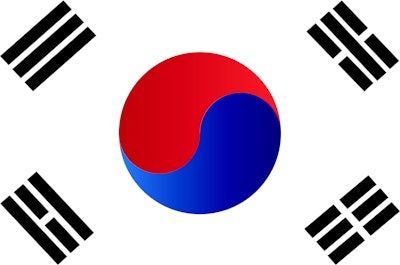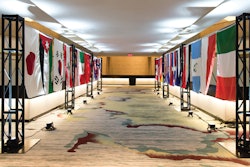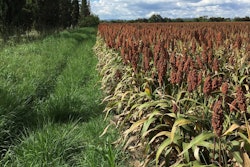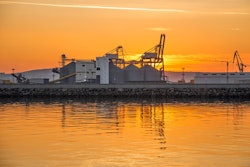
Many of the U.S. Grains Council’s (USGC’s) successes today are the results of efforts to lay groundwork years — even decades — ago. The Council takes prudent risks and makes judgment calls every day that are necessary to build tomorrow’s export opportunities. One market that clearly paints that picture is South Korea, which purchased nearly $2.5 billion worth of U.S. feed grains in all forms during the 2014/2015 marketing year. It is on track to continue that trend this year, as Korea is the fourth largest market for U.S. corn and distiller’s dried grains with solubles (DDGS) for September 2015 through February 2016.
The Council’s engagement in Korea has included a complete assortment of initiatives, ranging from value-added food products promotion to educating biotechnology regulators and engaging with industry and government officials to promote open market policies. All of these programs have been focused on growing and developing this Asian feed sector into the mature market that benefits U.S. farmers today.
USGC pivots toward Asia
The story of the Council’s involvement in Korea began in 1970, when U.S. feed grain exports to Europe had declined significantly and experts were recommending that the Council expand its vision into Asia. Working off of these recommendations, the organization opened an office in Korea in 1972.
From the beginning, this office led the way in demonstrating how the U.S. beef feedlot system could work in Asia. The Council launched the Daehan project when it shipped 264 U.S. beef calves to Korea to be put into a feedlot operation in that country.
Upon arrival, the Council offered guidance for designing a beef feedlot, formulating rations, livestock management and the slaughtering process.
This was the first activity of its kind in Asia, and it successfully demonstrated that the U.S. feedlot system could work in Korea. As the system spread across the country, it generated new demand for U.S. feed grains to be used in rations. As the project gained success, it was also used as a model in other Asian countries including Japan.
Focus shifts to pork and poultry
Following the success of the beef feedlot program, the Council began examining Korea’s demand for other meat products, which can be a driver for increasing the usage of coarse grains in animal rations.
In the swine industry, the
Council undertook a program that helped the industry adopt integrated business models. Today, about one-quarter of Korean pork is produced by 21 large integrators, who have improved productivity by expanding their operations and staying abreast of new technologies.
This has caused the swine sector to become the primary driver of coarse grains consumption in Korea. In 2015, the industry utilized 6.1 million metric tons of feed, or 32% of the nation’s total mixed feed production.
While the Council was rolling out this pork program, it was also beginning a poultry sector development program, which gave the poultry industry access to modern production technologies, management and business systems and marketing models that were critical for expansion.
As Korea’s poultry industry grew, local producers established a check-off program that has helped the Council sustain the sector’s development. The check-off program promotes poultry consumption and helps the industry adopt modern poultry production and marketing practices.
Between the USGC’s engagement and the establishment of the check-off program, the Korean poultry industry has experienced a sevenfold increase, going from 21 million birds produced in the early 1970s to 159 million birds today. In 2015, the Korean poultry industry consumed 5.6 million tons of mixed feed, which represents 30% of the nation’s total mixed feed production.
Pivoting towards missions, trade teams and trade servicing
The Council’s promotional efforts in the 1970s were strictly focused on livestock uses and developing that industry. However, in time, the Council expanded its focus to take a new approach to its work in Korea, including programs that taught overseas customers about the U.S. grain marketing system and how it works.
To that end, in 1982, the first team of producers from USGC member organizations traveled to Korea, Japan and Taiwan to promote the advantages of U.S. coarse grains. Between missions like the one in 1982 and other traditional market development and trade servicing work such as trade teams, one-on-one consultations and seminars, Korea’s demand grew to the point it was a major corn importing country.
Today the Council’s primary goal is to sustain demand for coarse grains and to regain market share of U.S. products lost due to an increasingly competitive global market as places like Argentina and Brazil expand their production capabilities.
For example, in 2012/2013 when the U.S. Corn Belt experienced a crippling drought and U.S. corn became uncompetitive in the global market, Korean buyers only purchased 459,000 tons (18 million bushels) of U.S. corn. However, the Council remained engaged in this market to assure Korean importers of the United States’ ability and determination to reliably supply enough quality grains to meet both U.S. domestic and export demand. This paid off when a major rebound occurred in 2013/2014, with Korea purchasing 4.9 million tons (192 million bushels) of U.S. corn valued at $1.1 million, making it the third largest market.
Free trade paves the path to today
In the 2000s, Korea and the United States began negotiations on a free trade agreement (FTA) that would eventually lock in duty-free access for U.S. corn and create new markets for other agricultural products, like U.S. DDGS and barley. The KORUS agreement entered into force in 2012, and since its ratification, it has offered opportunities for the Council to further develop sales to this mature market. Examples of this include the organization’s increased DDGS promotional programming effort in Korea and new U.S. food barley promotional activities that help link Korean barley buyers with U.S. suppliers.
Increasing inclusion rates of U.S. DDGS
One commodity that received a boost was U.S. DDGS. While the Council had been promoting this corn co-product to Korean buyers since 2004, the FTA locked in its duty-free treatment, paving the way for robust market development work focused on the use of U.S. DDGS in livestock and poultry rations.
Efforts to do this have been geared toward educating end users and nutritionists on the economic value of the corn co-product. Through targeted technical programs, including webinars and one-on-one consultations, the Council is working to help Korean commercial feed millers become fully conversant with the nutritional and economic value of U.S. DDGS. This is intended to help them increase their inclusion levels of U.S. DDGS while teaching them how to procure the corn coproduct efficiently.
If Korean buyers increase DDGS inclusion rate in livestock and poultry diets to recommended levels, it is projected that Korea could import 1.2 million tons of U.S. DDGS within the next five years.
Next pivot: ethanol
The next frontier for the USGC in Korea is U.S. ethanol export promotion. Korea purchased 217 million liters (57.3 million gallons) of U.S. ethanol during the 2014/2015 marketing year valued at $116 million, making it the fifth buyer of the product.
While most of those sales were for alcohol beverages and industrial uses, the future for fuel ethanol imports is bright with the Korean government beginning to enforce a 2.5% biodiesel blending mandate. While Korea works to decide and develop their future fuel ethanol policies, the Council believes that market development work can promote interest in Korea for U.S. ethanol and potentially create demand for it as a fuel source.
The USGC is beginning work that will improve Korean consumers’ attitudes toward ethanol as a fuel source and secure ethanol-friendly allies. By educating and supporting relevant industries, policymakers and the public on energy security, the environmental benefits of U.S. ethanol and the economic advantages of the renewable fuel, the Council believes it can create and develop a demand for ethanol in Korea.
Always Pivoting
Change always has and always will be a byword of Council programs. USGC’s ability to redeploy resources to exploring new pockets of grain demand within Korea has made the Council relevant today.
Korea has grown into one of the top markets for U.S. coarse grains as buyers from that country purchased nearly $2.5 billion worth of U.S. feed grains in all forms during the 2014/2015 marketing year.
As the Council continues to look at U.S. grain exports in all forms, the organization will evaluate and re-evaluate its strategy in this market looking for new opportunities and ways to overcome previous challenges, which will be key toward maintaining Korea’s leading U.S. importer status. ❚

















